2025 NFL QB Rankings - Stats vs. Film
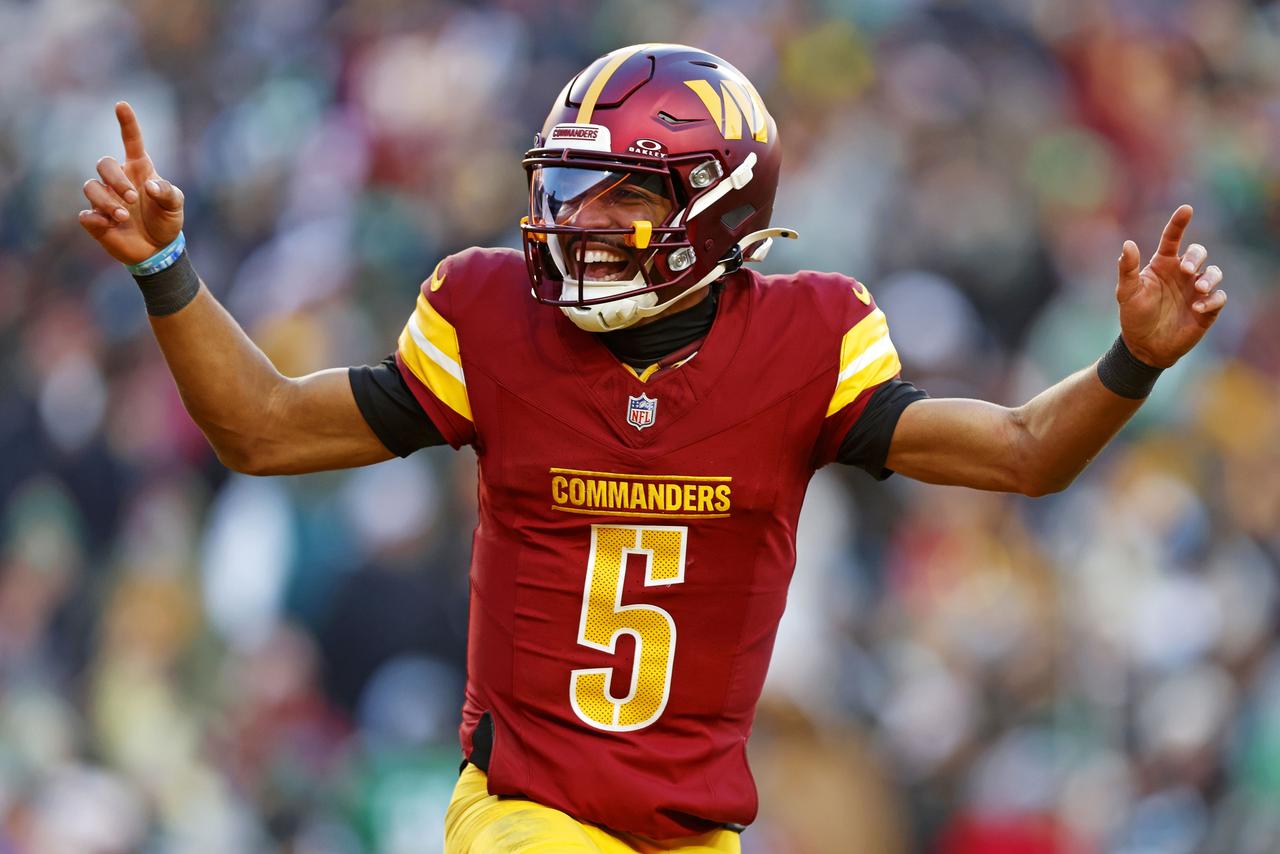
This column is entirely a projection forward to the 2025 NFL season, and they are solely about the player, not the team they play for. There are some QBs who will have much better (or worse) stats than their grades because of the enviornment around them. This is purely who is the best in a vacuum. In preparation of these QB rankings, I watched every QB I ranked on all 22 to grade out their biggest throws, worst decisions, and best plays with their legs. I included as much tape as needed in the column, but I have more over here and on my YouTube page where we'll be discussing these rankings eventually.
MVP Favorites
1. Lamar Jackson: The 2024 season was the final leap needed for Lamar to become close to unguardable. At 28 years old, he's every bit of the athlete he needs to be in open space as a scramble and thrower on the move, but now he's one of the best in-pocket QBs. His arm is stronger than most of the dual-threats, and he's easily the best rushing QB in the NFL. He had the most designed QB runs for a first down and remains lethal as a scrambler. A few of these runs legitimately made me laugh.
More importantly, the addition of OC Todd Monken created a more functional pass game, and Lamar frequently read things out to the backside and to the checkdown. On throws beyond 2.5 seconds from the snap, Lamar had a 29:1 TD:INT ratio, leading to the best PFF grade on those attempts. That is outrageous. He led in positively-graded throws and had the lowest interception rate when throwing over the middle (0.7%), too. The throws he made in the red zone were amazing, specifically a few of those high-point balls to Mark Andrews and the corner shots after holding a zone corner with his eyes. If he's now avoiding negatives and is consistently great inside the pocket, then what else is he really missing? The only thing to critique is a 3-5 record in the NFL Playoffs, but even that is inching closer. Over the past three postseasons, Lamar's EPA per play only trails Jayden Daniels and last year's loss to the Bills can be blamed on fumbles, not the offense's 92nd percentile series success rate. It feels like he's riper than ever to finally reach the AFC Conference Championship, if not further.
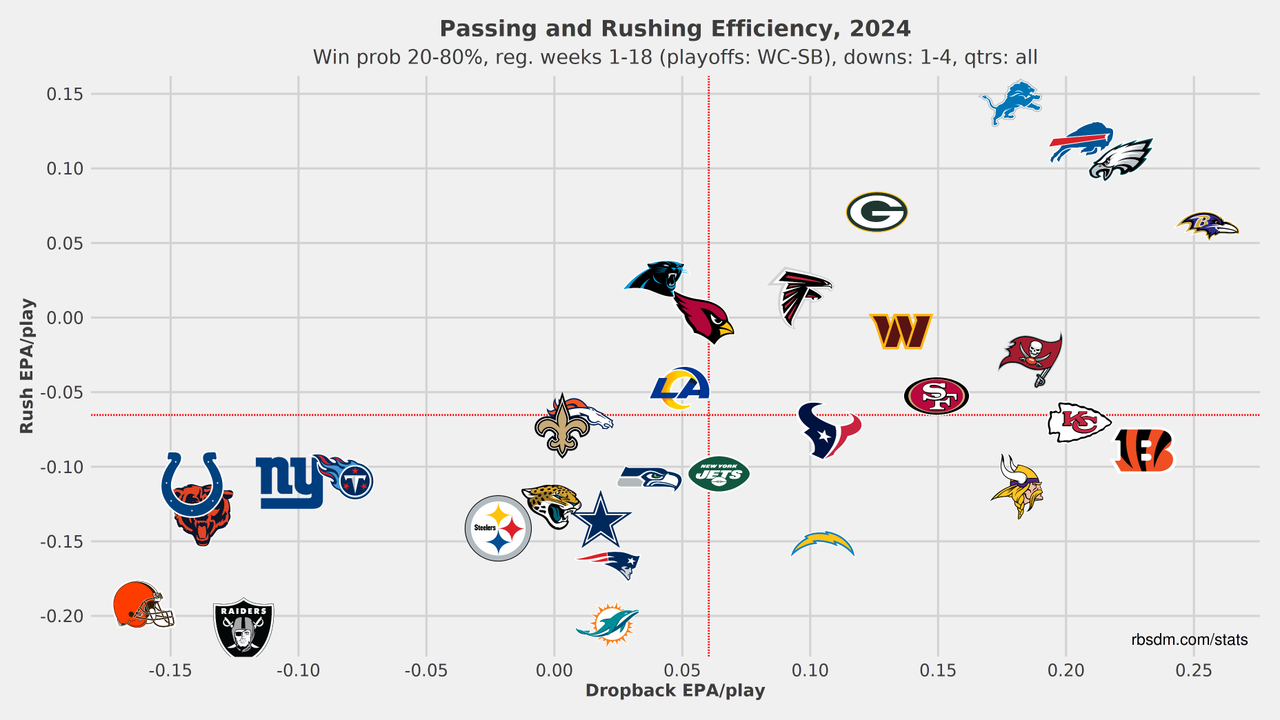
2. Patrick Mahomes: Over the past three seasons including the NFL Playoffs when he's won two Super Bowl MVPs and lost another, Mahomes leads the NFL in EPA per play (+0.26) and success rate (53%) once removing garbage time. He's also first in winning percentage (81%) over that span. He's simply on pace to rival Tom Brady as the best QB of all time. The primary difference is even in down years, Mahomes was still the QB3 in 1st-downs added as a scrambler, something Brady never did. In general, the past couple of regular seasons have been his worst yet, but all of that can be blamed by a lack of speed, forgettable outside receiver talent, and inconsistent tackle play. Mahomes has morphed into an underneath assassin to overcome those issues, ironically speeding up his development into a player who can win in any game script against any coverage with any type of supporting cast. Even in those situations, Mahomes made freakish plays, like this one to DeAndre Hopkins:
To firmly get back the QB crown, Mahomes just has to connect on more downfield shots in 2025 after missing Xavier Worthy repeatedly last season, because now everything within 15 yards is a layup line for the QB with the most playoff wins (17) and playoff passing touchdowns (46) through their 8th NFL season. For reference, Brady is the QB2 in each stat at 14 and 24 (!!!) respectively. What has been frustrating is Mahomes can obviously throw deep whenever he wants with elite arm strength, as seen on that Super Bowl post shot. He also can run far more than he does, if he wanted to. Mahomes has Houdini moments near the sideline and at the first-down marker, plus can truck his way into the end zone. His first QB designed run came in the Conference Championship, of course going for an impressive TD. At his very best, Mahomes is the best player in NFL history. Please tell me the Chiefs allow him to showcase that during the regular season, too. I miss it.
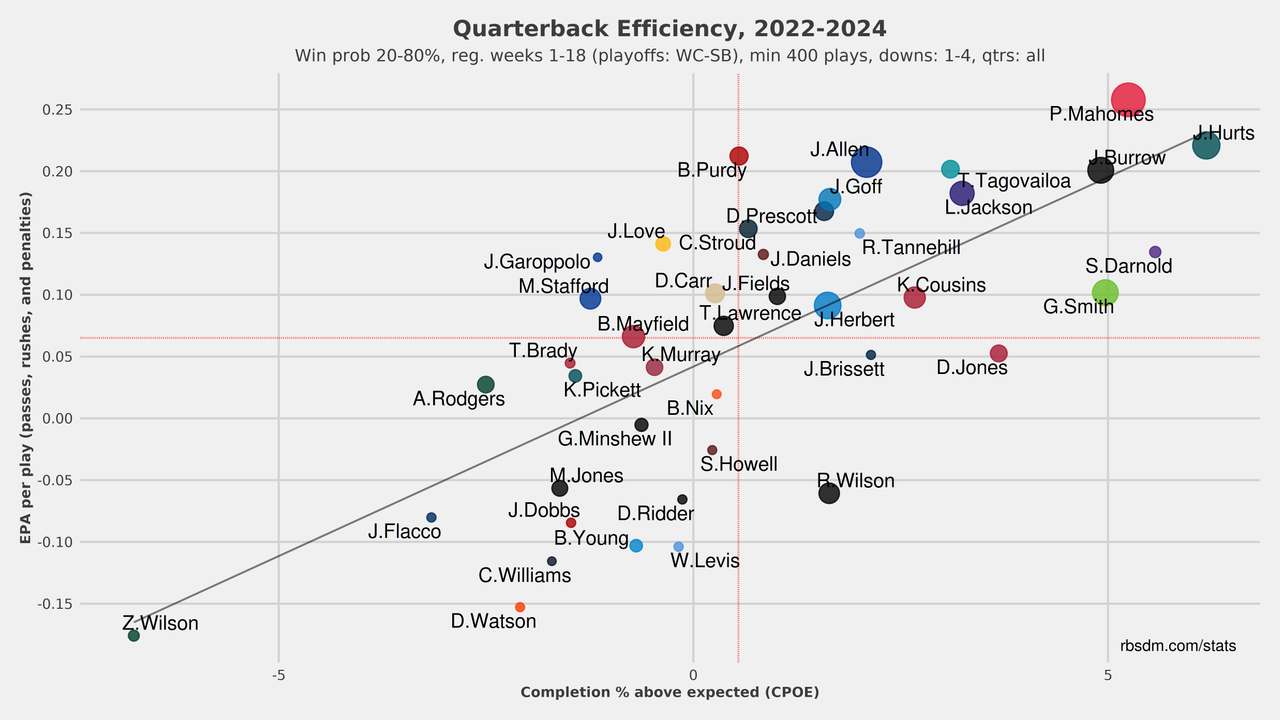
3. Josh Allen: After years of development, Allen is firmly in his prime as a 28-year-old blessed with elite athleticism and a maturing play-style. His elite arm talent, showcased by throws delivered downfield, to the perimeter, and on the move with unique arm angles, is complemented by a calmer-than-ever demeanor. Allen had the best sack rate, while also having the highest success rate on checkdown plays. He's now 2nd in success rate and 3rd in EPA per play over the past 3 seasons despite having the entire offense run through him with a mediocre skill group around him. For as good as his arm is, the real treat is his rushing production. Allen only falls behind Jalen Hurts in EPA on QB sneaks and led all QBs in EPA per carry overall. He's close to a Cam Newton in the red zone and close to a Matthew Stafford in the dropback game. His toughness and size allowed him to be the only QB in the NFL to generate a positive EPA per play while under pressure (total blasphemy) and makes him a cyborg every January as two feet of snow covers the Buffalo bleachers. Allen is a Hall of Fame talent, who just is a little more mistake prone (7 fumbles vs. pressure were the most in the NFL) and a little less polished in the normal dropback game as the two freaks above him. And even there, Allen is an asset.
4. Joe Burrow: When not busy getting a fit off in the tunnel, Burrow is the NFL's premiere pure dropback quarterback with the best mix of football IQ and pocket movement. He has a pre-snap answer to almost everything, and he can process post snap better than anyone right now. He was 2nd in EPA per dropback last year and the QB1 in completion percentage over expected on late downs. Burrow's sensational 2024 was even more special when contextualizing that the Bengals handed him the highest neutral pass rate in the NFL attached to a defense that allowed the 7th-most points per game. His accuracy extends to every blade of grass, as he had the highest on-target rate on sideline throws last year despite below-average arm strength. How he gets there is by fully understanding what his arm can get away with. Burrow routinely feathers in deep passes by calculating just how much space a deep safety can cover. Of course, it helps to have two super star WRs to paint an easier pre-snap picutre, but let's not discount some of these throws to the other Bengals' skill guys:
Burrow has been smart, clutch, and accurate forever, but he showcased a new tool in 2024. Burrow led the NFL in EPA and success rate when moving or shuffling in 2024, and he was quietly the QB12 in EPA added as a runner. There was a real play-making element that had nothing to do with the neck up. Sneaky athlete, indeed. Burrow did have 6 fumbles against pressure (the 2nd most), so there is room for growth in this department, but we'll take the new skill at face value. In addition to just having a better understanding of defenses each year, this newfound mobility has vaulted Burrow into the bottom of this first tier.
MVP Moments
5. Jayden Daniels: The 2nd-overall pick exploded onto the scene as a rookie, finishing as the QB8 in EPA per play on the 15th-best success rate. Daniels also had a ridiculous +0.29 EPA per play in the NFL Playoffs to end the year. Aside from the rushing, Daniels' poise stands out. He can execute the quick game, RPOs, and screens with ease, but he was truly unfazed against the blitz. He had the highest success rate on plays with pressure and against 6+ pass rushers. Plenty of that was simply being the best athlete on the field. He easily added the most EPA as a runner (regardless of position!!!), nearly doubling the QB2 in first downs as a scrambler in particular. A few runs stood out. He shed a tackle from super star DT Jalen Carter during a scramble, and he identified a nickel blitz from stud CB Brian Branch and simply out ran him to the other side for another explosive. Daniels is out-athleting the best players in the NFL in ways that we're only seeing from Lamar and Allen.
Where Daniels can improve is having better feel during the in-pocket progression, which is something every rookie is expected to deal with and immediately improve upon heading into year two. Many of his big passing plays were predetermined throws to the sideline in 1-on-1 scenarios. It's impressive how many he made, but this wasn't the look of a well-seasoned veteran by any means. And that's okay! As a thrower, Daniels is fairly accurate with solid arm strength. Neither stand out at a truly elite level, but both are absolutely assets. With the additions of LT Laremy Tunsil, WR Deebo Samuel, and 1st-round RT Josh Conerly, and the continuity of OC Kliff Kingsbury, Daniels is poised to be one of the most compelling players to watch this upcoming season. It will not be a surprise if he climbs into the tier above by the end of 2025. He was 4th in EPA on late-down plays to put any critique into perspective. Total stud.
6. Justin Herbert: The fluky injuries, lackluster coaching, and disaster games in the NFL Playoffs (see the chart below) are distractions to what Herbert routinely brings to the table when healthy. Over the past two seasons, Herbert is PFF's QB3 in a clean pocket and QB4 against pressure. On 1st/2nd downs, QB4. On late downs, QB3. With play action? QB3. Without? QB4. Herbert can play in any offense because of his athleticism and can make every throw with truly world class arm talent. For a power thrower, Herbert's accuracy stands out. He's become a more aggressive thrower in the pocket over the years and even finished as PFF's QB1 on in-pocket throws in that 2.6-4.0 second window when the quarterback is often running through his post-snap progression. Herbert can be a little robotic in his motions and a little too chalkboard disciplined, but most of the time, that means he can fit in a dig route or a hole shot that many QBs wouldn't normally see. His passes never seems to die on tape. For that reason, Herbert is one of the most lethal play action assets in the NFL. There are moments where Herbert takes off running with burst and he has the size to withstand some big hits, but the injuries have prevented him from being a dual-threat asset. Hopefully his ribs don't stick out of his sternum and hopefully OC Greg Roman can encourage him to make more leg-driven plays. Eventually Herbert's NFL Playoff numbers will regress, as he has too much football IQ, toughness, and ability to not get hot soon enough. In general, the only differences between Herbert and the MVP Favorites are those different levels of escapability/playmaking and Herbert's slightly worse sack rates.
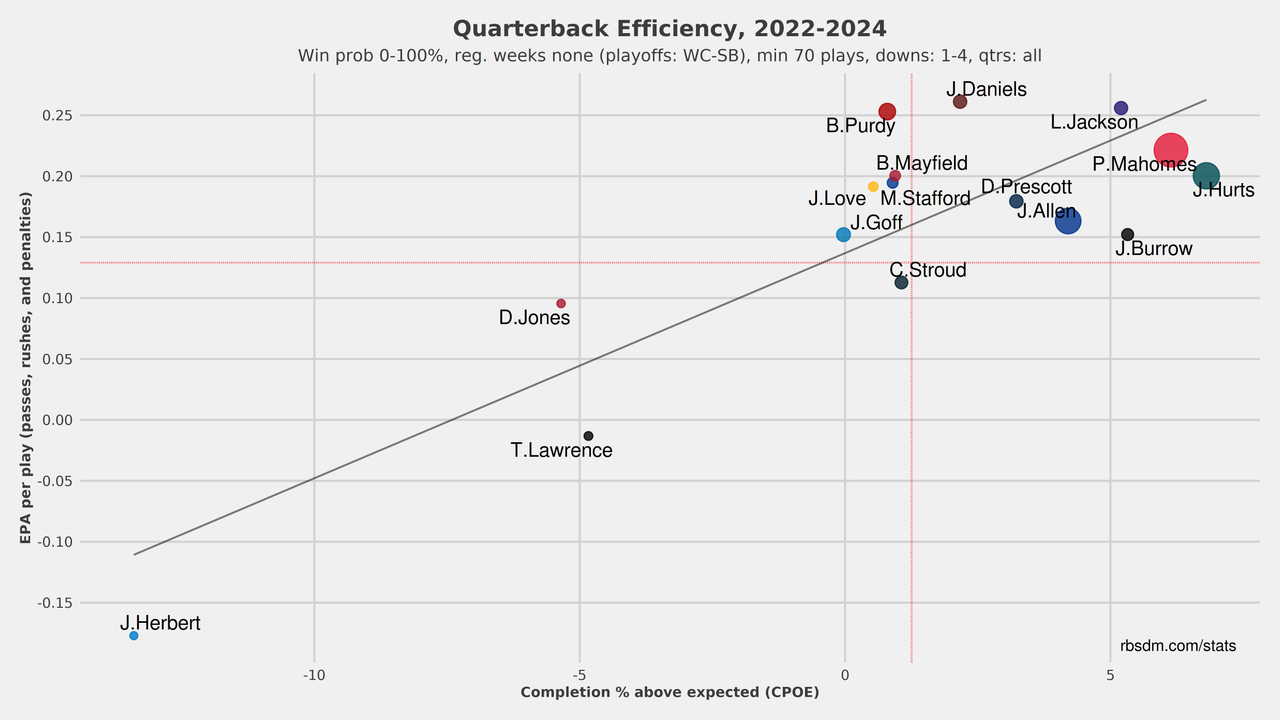
Heat Check QBs
7. Jalen Hurts: We just entered the prime of his career, just in case you missed his Super Bowl MVP outing. While not nearly as fast as others above him, Hurts is still a cheat code in the rushing department. He was 4th in EPA added on runs, including a signature +23.0 EPA added on QB sneaks which was 2.4 times more than the 3rd-best QB and easily the most in the NFL. Beyond the sneak, Hurts plays with power at the marker and Tier 2 speed out in space, as evidenced by this 48-yard TD on a counter run where he out runs the initial linebacker and sheds off a DT. The rest of his game has rounded out after some brutal stretches against the blitz. More reps against those looks has helped calm him down, and when he knows what an opposing defense is in, Hurts is damn good. His accuracy is the underrated part of his skillset, as he's the leader in completion percentage over expected (+6.5%) since 2022, and he has the arm strength to win over the top. His jump ball throws are extremely catchable because they come with ideal loft and always in bounds. The Eagles downfield success can't only be attributed to A.J. Brown, DeVonta Smith, and that elite OL. Hurts can sling it, now.
It's also impossible to ignore his aura and the clutchness of his results late in the year when his physicality and dual-threat skills really come in handy. On 3rd and 4th downs over the past three seasons including the NFL Playoffs, Hurts is the leader in EPA per play (+0.49) and success rate (54%) , which I only found out when researching Mahomes as I thought he'd easily be the leader there. There were credible times to nitpick Hurts' game, especially against the blitz, but the 27-year-old has learned a bunch on the job and is a difficult player to scheme against when healthy. In fact, when he had A.J. Brown and DeVonta Smith healthy last year, the Eagles were 14-0 including the playoffs. He's also won 78% of his games over the past three years. Let's not overthink this, even if he bails out of a pocket too quickly for a head-scratching sack or fumble more than we'd like.
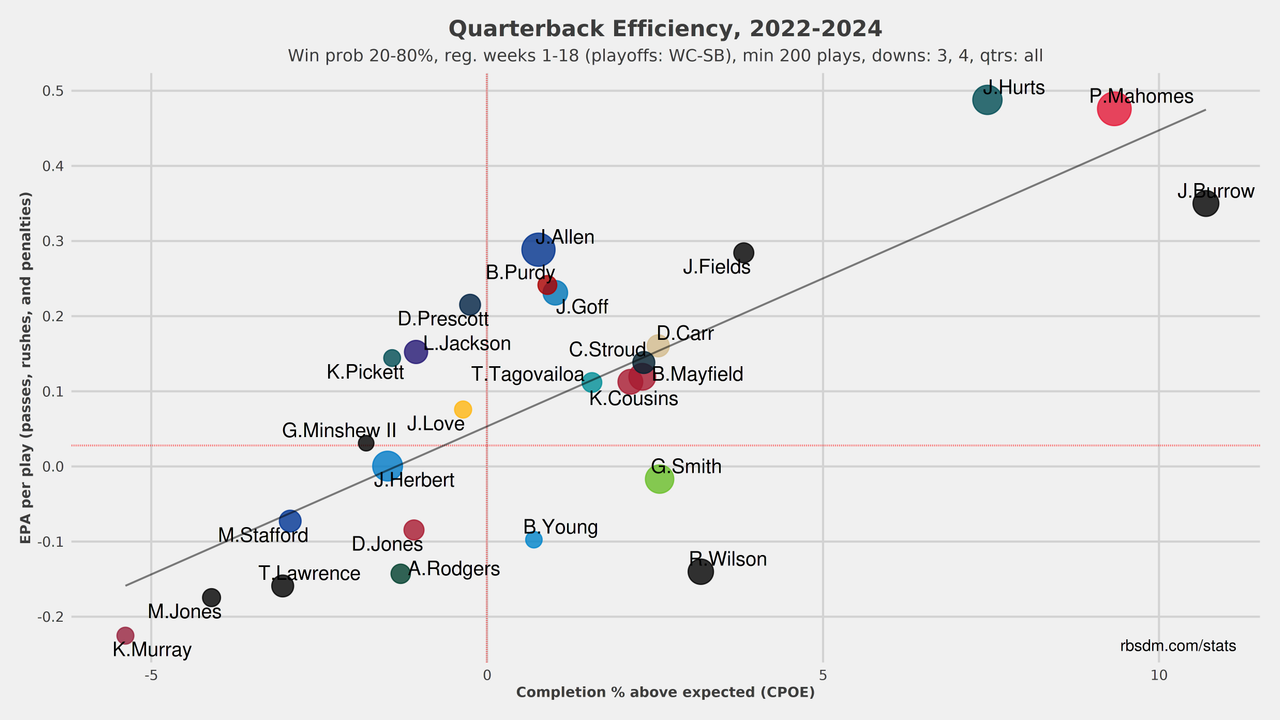
8. C.J. Stroud: I blame the coaching staff and OL for most of the Texans' regular season issues, and even with them, Stroud still had +0.11 EPA per play in the NFL Playoffs without his WR2 and WR3 available. When we filter out his league-leading unblocked pressure reps, Stroud has the film of an All Pro caliber in-pocket quarterback. There are only a few quarterbacks with better anticipation despite only playing for two years in the big leagues, and he has better arm talent than many of the cerebral-reliant types. There was a 60+ air yard completion to Nico Collins last year where he barely even stepped up to make it. Stroud's touch throws, in particular over the middle and into zone holes on the sideline, are highly impressive. He is comfortable turning his back to the defense on play action attempts, and he can make them on the run when needed. That last part will be the final determination of where Stroud lands within the top-10 list long term. Stroud has only averaged 12.5 rushing yards per game in the regular season, but he has flashed more scramble ability than that when he's needed it. That was 12 carries in the College Football Playoff against Georgia's historical defense, then exactly 6 times for 42 yards in both playoff games this past year. If Stroud can reach into that play-making bag a bit more once he's settled in with a new protection plan up front, then he can be a young version of Joe Burrow as soon as this season. There's really no need to cite a bunch of stats throughout his career because new OC Nick Caley is going to be a big upgrade for the Texans. I guess Caley will given Stroud more autonomy up front, and I'm expecting a lot more throws with his feet planted this year. Stay tuned for the results.
9. Matthew Stafford: When actually healthy, the 37-year-old still provides MVP flashes with great arm strength and one of the best minds in the sport. Whether he can finish the season strong with his in-pocket bravery is a fair question. Pairing Sean McVay with Stafford has been a pre-snap cheat code. He's a master at the line and has seen every possible route vs. coverage hundreds of times throughout his career. There are throws he attempts to the sideline and over the middle that most QBs can't comprehend. Stafford often controls zone CBs with his feet and eyes to rifle in intermediate throws. Last year, there were some signs of decline. Stafford was simply less accurate than before. He was PFF's QB28 on throws beyond the sticks, often overthrowing passes with pressure at his feet. He had the most turnover-worthy plays of any QB on this list while under pressure, all while having the 2nd-quickest time to throw. Those numbers are because he's struggling to buy as much time as he did before. It's possible that having an X-receiver presence like Davante Adams dims those concerns because he creates so much instant separation and has the mind meld needed to execute this intricate offense. Stafford has massive splits with Puka Nacua as well. From Week 8 on last year, he was the QB9 in EPA per play and nearly upset the Eagles in the NFL Playoffs. His best outing can be a firework show if the accuracy is on point, but let's pay attention to LT Alaric Jackson (NFI) this offseason. The second the pocket starts collapsing, the less Stafford has to offer. He's the QB17 in EPA per play over the past 3 seasons. It's been an up-and-down couple of years, and a lot of that can be explained if his OL is healthy or not.
10. Geno Smith: When throwing from the pocket, Geno can deliver some seriously impressive 20+ air yard highlight throws, showcasing a slick motion with the ability to throw with both power and touch. He's been incredibly accurate, ranking QB5 in completion percentage over expected since 2022, and that span has included some of the worst OL play in the NFL and with two play callers who are no longer calling plays in the big leagues. When kept clean, Geno was PFF's QB7 last year and he even was the QB1 overall in success rate on check-down attempts. For the most part, Geno is cerebral player with a lot of experience. He attacks the middle of the field at a high level and has the arm to complete big out/corner routes with anticipation. He can stand tall under pressure and complete passes just before taking big shots.
Unfortunately, Geno's aggressiveness haunts him. Last year, he carried an 8% interception rate on late-down throws with 5+ yards to go, the worst rate of anyone listed in this column. Most of these negative plays happen in the 3rd, 4th, and 5th second after the snap when he's attempting to make a heroic play out of structure. These in-traffic throws can cost games, and he only adds 16.0 rushing yards per game to make up for them. His rushing is only used as an effective surprise, but Geno lowkey has some wheels. There were a couple of zone read chunk plays and a sick long TD from a scramble that featured an open field shimmy. He doesn't want to use his legs often. It will work in a pinch, however. All in all, Geno has been the QB19 in EPA per play and QB13 in success rate recently, but a more balanced offense with OC Chip Kelly could be the exact system to get the best results out of Geno's skillset. Expect a bunch of under center play action shots to the intermediate and deep levels of the field.
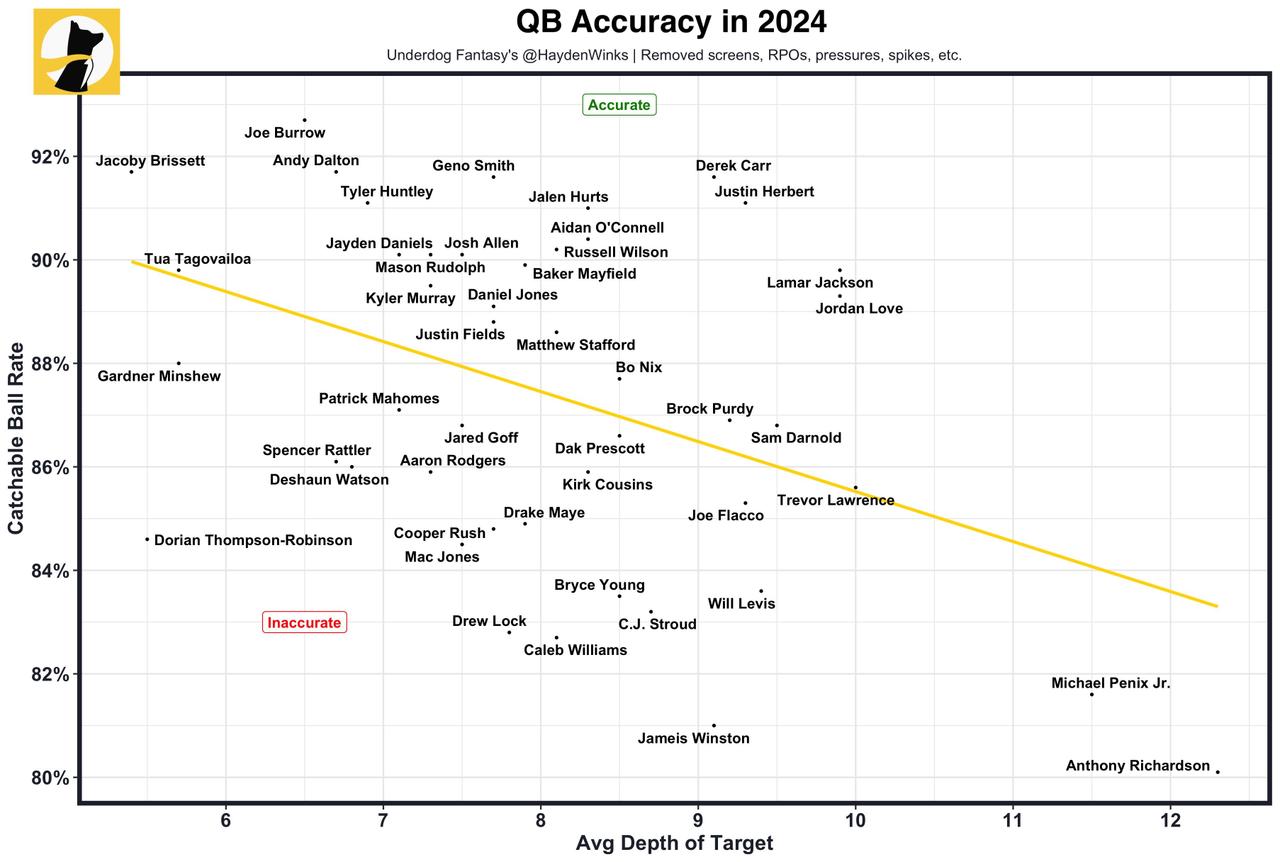
11. Jared Goff: The 30-year-old is playing the best ball of his career right now, an absolute master pre-snap and legitimately in the conversation for the most accurate QB with his feet set. Goff is in rhythm more often than not, which is why he was QB1 in success rate (54%) against 4-or-fewer pass rushers last year. Goff has been a major beneficiary of an elite offensive line, a brilliant play-caller, and a stacked collection of weapons, helping him to be QB4 in success rate and QB7 in EPA per play over the past three years. That said, he's getting more aggressive, standing taller in the pocket, and taking hits far better than earlier in his career. That makes Goff an asset on play action in particular. There are multiple 60+ air yard completions on tape, even if he's not viewed as a strong-armed quarterback. He also has some of the best touch throws to the sideline of any active quarterback. Goff can throw dig routes with precision when he's feeling spicy, and he does all that while handling a bunch of things pre-snap at the line of scrimmage. Of course, Goff is only averaging 2.2 rushing yards per game over the past two seasons, so he has to be special in the pocket to compete in the NFL Playoffs. This year, we'll get a fresh look at Goff without an elite staff around him, as OC Ben Johnson and All-Pro C Frank Ragnow are out of the building. In previous years, I'd be quite concern about the fall off, but Goff has earned the benefit of the doubt with years of grooming from elite coaching staffs.
12. Jordan Love: The Packer has that undeniable "eff you" arm talent, with some of the most beautiful off-platform throws in the league. The issue? He's still too inconsistent with his ball placement and decision-making, which is why he landed at QB18 in success rate over the past three years. Last year, Love was QB30 in on-target rate over the middle and more concerningly was the QB22 in avoiding negatives per PFF. He's a natural thrower, so the dip in accuracy is largely tied to trying too many wow throws. That said, he deserves freedom with his aggressiveness because he gets away with it more times than not. Love was the QB4 in EPA per play in 2023 before dipping to QB11 last year while battling fluky injuries. He's a great fit with coach Matt LaFleur, who calls a balanced but explosive game plan. There is schemed up production in here, but Love has also struggled to find man-coverage separators (who can catch the football after getting open) in clutch situations. Enter 1st-rounder Matthew Golden this year. Expect the 26-year-old with little experience to continue to fine-tune his decision making over time, and it's a good sign that he's already QB3 in pressure to sack rate despite his relative inexperience. Just don't expect him to close to gap with crazy rushing plays. He's sitting at just 10.0 YPG over his past two seasons.
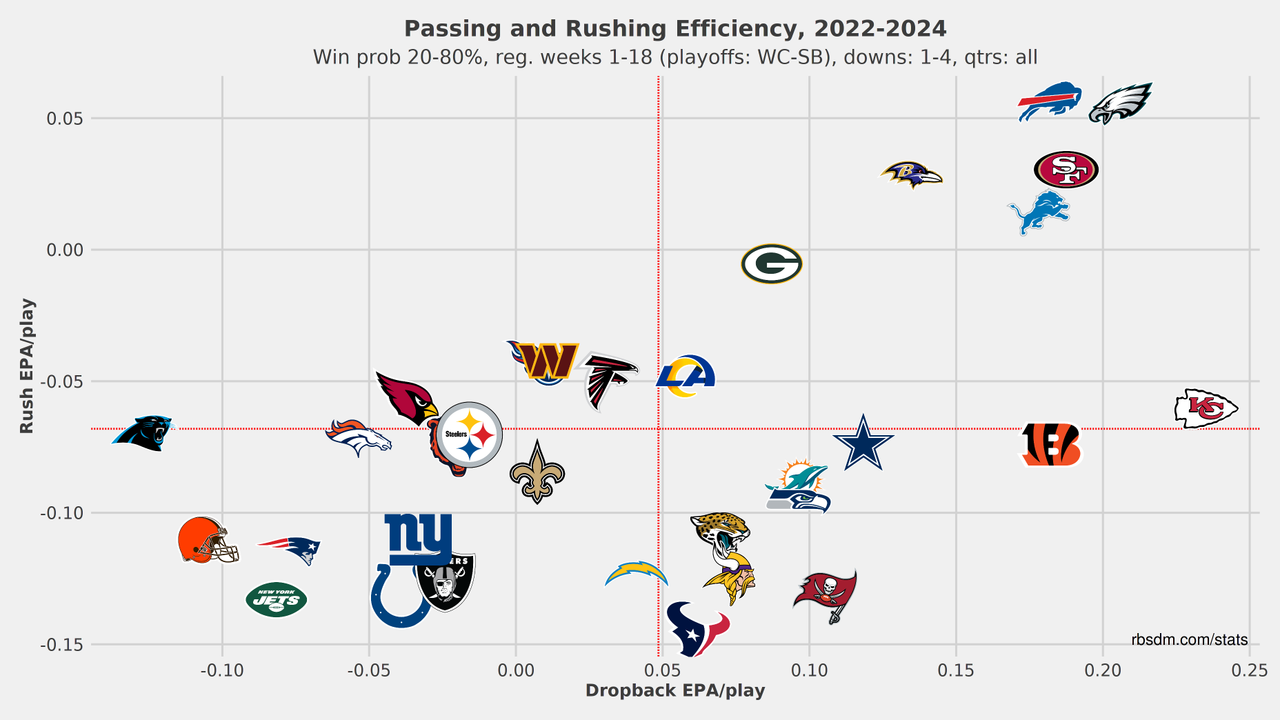
13. Dak Prescott: There are only a few quarterbacks who compare with his command of the offense. Dak is great pre-snap and is tasked with among the highest neutral pass rates each year. Despite that, Dak is the QB6 in EPA per play (+0.19) and success rate (52%) over the past 3 seasons. His 2023 season was MVP caliber (36:9 TD:INT), while last year's hamstring injury fully derailed a more lackluster campaign. When he's healthy, Dak can dice up defenses as a classic in-pocket QB in the mold of Phillip Rivers. His aggressiveness up the seam is generally a great trait but can get him in trouble with interceptions when he's not accurate. Last year, Dak struggled fitting balls in and seemed to be throwing without his feet set more than normal, leading to the 3rd-highest turnover worthy play rate. He also was PFF's QB33 on throws beyond the sticks and was the QB39 in on-target rate on throws near the sideline. That wasn't a problem before and needs to rebound to live up to typical top-10 expectations. His 11.8 rushing yards per game since his ankle dislocation make him below-average playmaker, so that arm has to be ready. Of course, George Pickens is an ideal fit to fix these issues, as Dak was trying to make things work with backup-level receivers previously. Hopefully the fresh faces on the offensive line will come together because Dak with a capable structure up front is one of the very best at dicing up defenses. I'm a little nervous that the best of him is in the rear view.
14. Brock Purdy: Any QB capable of leading an offense to the 3rd-best EPA per dropback over a sample size of 3 seasons deserves a ton of credit, and in Purdy's case, his slice of the pie is getting bigger each year. The 49ers are doing more normal dropback with more 3-WR sets than in the past because Kyle Shanahan actually trusts Purdy to read things out and make stuff happen. Last year, his average completion was 7.4 yards downfield (only trailing full-send Anthony Richardson), he was PFF's QB6 in the standard dropback game, and he was the QB2 in yards per attempt against zone defense. That's beating the schemed-up or skill-group allegations allegations. Purdy's arm strength and physicality cap his personal ceiling--there are underthrows on could-be touchdowns on tape--but Purdy attacks the valuable parts of the field with timing and is perfectly suited with a "sneaky athlete" label. He had the highest 1st-down rate as a runner (50%), while adding the 3rd-most EPA on QB sneaks. There was a great rep beating star Jared Verse to the edge and he threw George Karlaftis to the ground on another. Aside from continuing to get better with decision making past the first read, Purdy's big room for improvement is throwing to the perimeter, where he was 40th in on-target rate (60%). That's probably something Shanahan will have to scheme around and live with unless Purdy somehow adds a bunch of MPHs to his throws. There is still enough good to hide the physical warts he might have, and the 49ers can win a Super Bowl with him if they get the OL and DEF going again. I really appreciate his game and development.
15. Baker Mayfield: Behind a fantastic OL with two high-end receivers, Mayfield has turned into a voluminous stat collector in Tampa Bay with two different coordinators. He was the QB9 in EPA per play with Dave Canales, then the QB6 with Liam Coen last year. Thanks to an elite scheme, Mayfield even was the QB4 in success rate while getting the ball out quicker than ever, but he still has a negative plays problem in two ways: sacks and interceptions. He takes on a lot of risk with his play style, leading to the QB28 turnover worthy play rate and 16 INTs. But his aggressiveness comes with real strengths. He can sling it as well as any 6-foot quarterback can and can play with touch as well (QB7 in completion percentage over expected). What's new for Mayfield is the mobility. He always thought he had enough gas to turn the corner, but last year, Mayfield's view of himself actually matched the results. He was PFF's QB2 on throws outside the pocket and he set a career high in rushing yards per game (22.2), doubling his career average. Mayfield is one of the wildest quarterbacks to watch, especially when he's talking shit while trucking defenders. On 8-of-10 plays, that's a good thing. On 2-of-10, well, that's why he's not quite inside the top 10 yet.
16. Bo Nix: The narratives around his rookie season (+0.05 EPA per play) swung too far in both directions. Nix did benefit from Sean Payton's well-designed weekly game plans, which featured plenty of gimmes, but he also made plenty of plays with his arm and legs. The latter goes underrated. Nix was the QB2 in 1st downs added as a scrambler, plus the QB4 in EPA added on QB sneaks. He has real speed and toughness. There were a couple red zone scramble TDs, plus a few highlight runs where he beat stars like Derwin James, Khalil Mack, and Trey Hendrickson with burst. Nix's arm strength is capable, as well. There were high-end posts and seams on tape, (fun fact: his 67-yard completion in the air was the longest of any QB last year) though he also threw the most checkdowns per game at 6.1. Nix must be a more aggressive decision maker to take the next leap, and a lot of that will happen as he trusts his eyes more in this complex system. Nix felt a bit rushed at times, opting for the outlet throw in lieu of a potential chunk gain. When he did pull the trigger, things were a mixed bag. His accuracy was fantastic in college but wasn't as pinpoint during his rookie year. He also was the QB28 in avoiding negatives and the QB34 in success rate when throwing over the middle. No doubt both metrics get better every year attached to Payton, and in the meantime, the Broncos adding better yards-after-catch athletes will provide a boost. At the very least, Nix is a capable playmaker with his legs, can physically make all the throws with league-average arm strength and accuracy, and perhaps most impressively already ranked as the QB3 in sack rate as a rookie. That's a solid foundation as he rounds out the rest of his game. He is on track to be an above-average starter in the NFL with time, possibly as soon as this year.
17. Sam Darnold: There were flashes of a more mature Darnold with the Panthers, but Kevin O'Connell unlocked the former 3rd-overall pick by letting him rip deep shots relentlessly with the Vikings. Darnold's 3.1 seconds to throw is the most among the non dual-threat quarterbacks, and the gunslinger had the 4th-highest average depth of target against zone coverage. His eyes are aggressive because he has high-end arm talent and some escapability if the deep shot is covered. That arm has equated to the 2nd-best completion percentage over expected, the QB7 in success rate, and the QB12 in EPA per play over the last three years. Darnold ran hot on the deep ball in 2024 (1st in WAR on late-down throws with more than 5 yards to go), but these type of metrics can go from hot to cold quicker than you'd think. Just take these stats for example: Darnold had more big-time throws than any QB after 3.0 seconds but also had the most turnover-worthy plays. Boom. Bust.
Equally important to his breakout, however, was his handling of pressure at a career-best level. In fact, Darnold was PFF's QB3 against pressure. Read that again. He will still take too many sacks and turnover the football as part of his downfield aggressiveness, but he stood tall and delivered high-end throws with a defender closing in more times than not. Darnold's QB32 ranking in turnover-worthy play rate is something that teams have to live with, as that's been a trait of his since his USC days. Last year, it was those 6 fumbles against pressure. We'll see if the Seahawks have enough downfield separators to run the Darnold and OC Klint Kubiak offense and if there are new traits Darnold picks up in his age-28 season. In generally, 2024 was a real breakout because his arm talent because very obviously a massive asset. He should get more confident with the post-snap picture over the next few seasons as his experience continues to help calm him.
18. Kyler Murray: Over the last three years, Kyler has been QB24 in EPA per play and QB22 in success rate, winning just 39% of his starts. We saw a more robotic version of Kyler in the Cardinals' balanced, underneath offense last year. He was 40th in average depth of target against zone coverage, and he couldn't push the ball downfield on late downs. I found this disgusting 3.6 yards per attempt on 3rd/4th downs with 5+ yards to go while looking at filters. This is a complete 180 from his pre-ACL tear days when he'd just heave it downfield or take off scrambling. Kyler spent a bulk of the season figuring out those back-shoulder throws to Marvin Harrison Jr., and his height is a clear weakness when scanning the middle or finding receivers under pressure. One is out of his control, but he and Marv must be on the same page in 2025 or nothing really matters. Kyler needs to hang in the pocket a bit longer for that to be a reality, as there are some spinning away reps that can ruin his accuracy. At the same time, Kyler had some freaky backpedaling reps and throws on the run still. Despite being his size, the ball can jump off the screen when his feet are underneath him. Despite being the QB1 in EPA per carry on designed runs, he only had 24 carries for some reason. We'd have to assume he begins running more with the pressure at a 10, but the offense is returning largely intact, so no promises. Hopefully, we'll see a blend of this structured approach and his old playmaking self this year, because if it doesn't happen now, Kyler's top-8 upside hope might be over.
Currently Too Volatile
19. Caleb Williams: His rookie year resulted in a brutal -0.10 EPA per play, so this ranking is a pure projection and an anchor to the level of prospect he was. Caleb wasn't comfortable in the Bears' offense (for some reasons beyond himself), and he made mistakes he didn't in college. His accuracy was shockingly bad at times, even finishing as PFF's worst graded QB on attempts beyond 15 air yards. Some of those negative accuracy results were caused by being pushed off his spot due to a bad scheme and line, but some of that was him being a tick late on reads. Caleb was overly robotic while trying to read things out but didn't have a machine-like quick trigger when receivers were open (and not heading to the bench in the middle of a play). That same issue created the 2nd-worst pressure to sack ratio in the NFL and too many hits while releasing the ball. A lot of these details will get ironed out with coach Ben Johnson and the new starters up front, however, and Caleb was already handling pre-snap protections and working through back-side progressions at times. Even while things swam on him as a rookie, he still flashed playmaking on the move. It was far from consistent, but his best five reps are up there with QBs inside my top-10 overall. Caleb was the QB6 in EPA added on QB designed runs, and he forced the 2nd-best missed tackle rate as a scrambler. He's not huge or lightning quick, but he's a ballplayer who will have a healthy portion of off-platform throws and did have some Houdini movements buying time in the pocket. It felt like Caleb was overthinking everything as a rookie, and I trust things will feel calmer and more decisive in year two. There's a chance he climbs much higher than this quickly.
20. Trevor Lawrence: There have been flashes from Lawrence in awful enviornments, but through four years, nobody really should be confident in where he tiers in QB rankings. He's played through serious injuries, too, so it's hard to tell if the tape I'm watching is lying. Generally, the 25-year-old is has been super aggressive to a fault. His terrifying -0.61 EPA per pressured dropback last year was the worst in the NFL, and he had a 9% interception rate when throwing over the middle, only trailing Kirk Cousins. Lawrence also threw into his first read on a league-high 76% of his attempts last year, putting him in the same tier as QBs you don't want to be near. He needs to improve with his decision making to live up to his prospect hype because his physical profile has some pros and cons. Lawrence has above-average arm strength when his base is set, and he's looking to use it. There isn't a hole shot he turns down, evidenced by being the QB3 in average depth of target against zone coverage. He does slide around the pocket well on most of his reps, something he's had to do a lot because of a bad Jagaurs OL. But at the same time, Lawrence's accuracy has been off throughout his career. He was 5th-worst in completion percentage over epxected and the QB35 in turnover worthy play rate. Some of those interceptions are just missing the target. Another chunk of those turnovers stem from having gumby-like movements as a playmaker.
All in all, Lawrence has recently been the QB23 in EPA per play and the QB24 in success rate. Enter Liam Coen and Travis Hunter. Expect more underneath plays to give Lawrence a mental breather, and hopefully that also translates to a better selection of aggressiveness with proper shot selection. He needs to read the field better in year five to climb a tier. He needs to be more accurate, set his feet, and make more plays with his legs to climb two tiers. It's way too early into his career to write those events off, but it's fair to critique his play from the past two years. And even if he doesn't, there are still crazy throws like the one above sprinkled in.
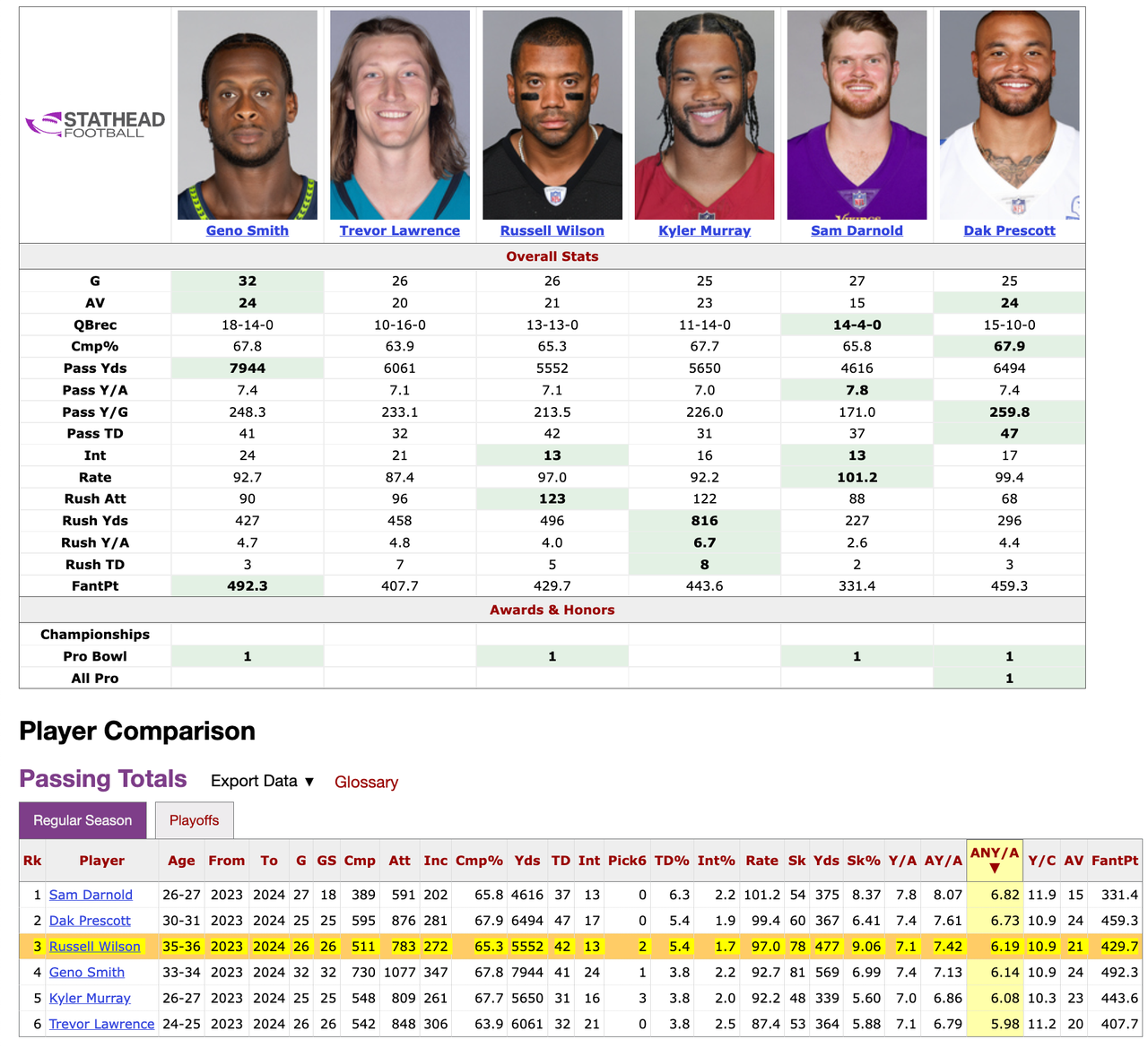
21. Russell Wilson: The 36-year-old is a true boom-bust downfield shot artist with glaring strengths and weaknesses. Since 2023, he's been 2nd in big-time throw rate (only behind Josh Allen), and he was the QB2 in accuracy percentage between Goff and Mahomes last year per PFF. Russ was quietly the QB4 in the standard dropback game under a much-better play caller in OC Arthur Smith, on the 3rd-best turnover worthy play rate. Nobody talks about that. His game remains mostly predicated on delivering downfield shots, which can be streaky, however. His 10.5 yards per attempt on late-down throws with 5+ yards to go is the highest of any QB on this list, and Russ was the QB3 in on-target rate on sideline throws. Long story short, Russ's arm was still real good in 2025.
The problem? As usual, he still takes too many sacks and his mobility is declining. He was the QB37 in sack rate and the QB38 outside the pocket. The latter used to be his bread and butter, so his ceiling is fairly limited now that he's also only adding a career-worst 3.6 yards per carry. It's fair to acknowledge his positives in the play-action Steelers offense last year, while also being more fearful of what's to come in a new offense that is unlikely to be as tailor-made to suit his strengths. The results in New York will be boiled down to how pure he runs on the deep ball and making sure he stays near last year's QB3 turnover-worthy play rate ranking. I don't think he's been nearly as bad as recent narratives suggest, but this Giants' schedule is the hardest in the league early on and Jaxson Dart is warming up in the bullpen. It's equally likely he surprises a few teams early on as it is that he's benched by Halloween.
22. Aaron Rodgers: The 41-year-old's arm strength is still above average, and he remains a pre-snap wizard, but Rodgers' play has been impacted by immobility, conservative decision-making, and declining accuracy. In fact, he's dead last in completion percentage over expected since 2022 of any QB on this list. It hasn't helped that he's burnt 1-2 plays per game to prove a point to someone. Anyways, Rodgers had his career's lowest average depth of target last year while battling back from a torn achilles, and it's hard to see those out-of-structure downfield shots ever coming back at the same rate as his pre-injury peak. The only way he can bounce back statistically is if he can re-find the deep ball within the pocket. He was PFF's QB10 on throws over 20+ air yards last year but rarely attempted them. That's the OC Arthur Smith scheme, however, so it's possible that Rodgers blends his football IQ and quick-game ability with a more-aggressive play call to get above-average results. With Davante Adams in New York last year, Rodgers was the QB21 in EPA per play, but I'm optimistic there will be stretches of better play than that. It's just a matter of gelling in a new system and staying healthy as the oldest player in the NFL. It was a bit worrisome just how many plays he was settling for with the underneath throw.
23. Drake Maye: The 22-year-old looks like he was built in a prospect lab: huge, athletic, great arm, and an enthusiastic kid everyone loves. But as a rookie, Maye put up a -0.02 EPA per play as a work-in-progress starter. He was inconsistent scanning the field and didn't handle the blitz well, too often turning down throws that led to sacks (QB32 in sack rate). Maye also didn't get to the checkdown very often, possibly because that's pointless when he has difference-making speed. He was 4th in EPA per scramble and will be used a lot more than once in the QB designed run game. When Maye takes off, there's a Josh Allen-ness to his movement.
There's also some early Josh Allen to his pass game (complementary) (derogatory). Maye can drive the ball to the sideline and downfield with ease, but he also checked in as the QB9 in completion percentage over expected. His accuracy isn't perfect. Just better than Allen's was early on, especially when throwing with touch. That's where the optimism comes in. Maye will take major strides in his processing (PFF's QB32 in a clean pocket) and decision-making (PFF's QB30 in turnover worthy play rate) over time. As a rookie, there were too many missed zone defenders or overthrown passes into bad spots, but that's why the year two leap exists. The Patriots adding Stefon Diggs, Kyle Williams, two new OTs, TreVeyon Williams, and a new coaching staff should make an impact in 2025, even if the entire unit is still lackluster. Buy some Maye stock while you can, but let's be realistic about where we are in this development curve right now. He might be league average by the end of this year and ready to knock on the top-10 door in 2026. The upside is very evident.
24. Bryce Young: Through two seasons, Bryce has been extremely boom-bust. After a near-historic awful first season, he calmed down after a sophomore benching and played like an NFL starter. Overall, Bryce was the QB27 in EPA per play (+0.01) and QB36 in success rate last year. His small stature might seem like he'd be conservative in nature, but Bryce is a risk taker. He was the QB30 in avoiding negatives per PFF and was 10th in average depth of target. His bravery in the pocket resulted in some highlight anticipatory throws into buckets while taking some big shots, reminding me of an undersized point guard hitting a floater in the lane. His No. 10 ranking in pressure-to-sack ratio is also a positive, where it was a fatal flaw in year one. Bryce has the escapability gene and even collected some ankles out in space, ultimately creating the 8th-most EPA per carry last year regardless of position. Bryce's slipperiness is a strength, but the problem is that his size does seem to work against him more times than not. He's forced into making decisions much earlier into the play than bigger quarterbacks, which has some obvious cons. He's turnover prone because he throws balls without having the complete post-snap picture. Even in a clean pocket, Bryce was the QB27. On late downs? 31st. For those type of metrics to improve, Bryce has to play a lot of live football with a great coaching staff around him because he must be a defensive coverage wizard to really climb these rankings. Things already look much better in Carolina with Dave Canales, a fully returning OL, and the addition of Tetairoa McMillan, so now it's on Bryce to show how sustainable some of these under-pressure heaves that worked late last year are long term. These aggressive pre-snap decisions are really unique.
25. Tua Tagovailoa: When healthy, Tua is better than this ranking, but at some point his injury history and play late in seasons needs to matter. After the calendar turns to December and January, Tua's career TD:INT drops from 3:1 down to 4:3. His yards per attempt also slides from 8.0 to 6.9, as defensive coordinators start to patch the Madden glitches coach Mike McDaniels seems to create early every season. Tua's style of play typically doesn't translate when it gets cold either because he's a zero as a rusher, only picking up 5 1st downs as a runner last year for example. That said, Tua is still a solid starter in this particular offense. Since 2022, he's 6th in EPA per dropback, which is still impressive even if it's a tailor-made environment for him. Tua might be the most accurate QB within 20 yards, trusts his play caller to throw with anticipation soon after the snap, and can run the quick game offense with smoothness. He had the best success rate (62%) when his feet were planted even after removing screens and sweeps last year, per SIS. Tua routinely puts the ball right on the money to allow for maximum yards after catch ability, but at the same time, he's not an aggressive thrower. He was the QB42 in average depth of target against zone coverage, his -3.0 yards to the sticks last year was the lowest per NextGenStats, and he was the QB38 in big-time throw rate. Ultimately, Tua can upset any team when the Dolphins are healthy, but it's an entirely fragile operation in a game that requires resiliency.
Complete Uncertainty
26. Cam Ward:
27. J.J. McCarthy:
28. Michael Penix: A 3-game sample against some of the worst defenses (CAR, WAS, NYG) is not enough to fully evaluate, so I'll pair what I saw as a prospect with this glimpse of NFL action here. Penix's top trait is his arm strength. It's flirting with elite already, at least on the ones needing to be rifled in on a line. He's a line drive thrower with great strength, and he's an aggressive decision maker because of it. On normal dropbacks last year, Penix had a ridiculous 11.5 average depth of throw, only trailing Anthony Richardson. Like AR, Penix sails too many throws because he doesn't quite have the touch or ability to throw on the move. For now, his accuracy is below average even in a clean pocket. It's too early to tell about his poise and decision-making against NFL speed. None of his 3 INTs as a rookie were his fault, but there were also near turnovers on other plays. Most aggressive power throwers with some accuracy issues end up being interception prone, and I see some Jameis Winston attributes here. Penix isn't a dual-threat at all. His 4% scramble rate was well below average, and the Falcons only added some mini bootlegs by design. Long term, Penix is going to have to consistently win inside the pocket. If he can reign in that arm and pick his spots wisely, the arm can carry him well above this ranking. If he can't, then there isn't a fallback trait to land on. Penix is as boom-bust as any on this list.
29. The Jets:
30. The Colts:
31. The Saints:
32. The Browns: Idk who I'm even supposed to be evaluating here.